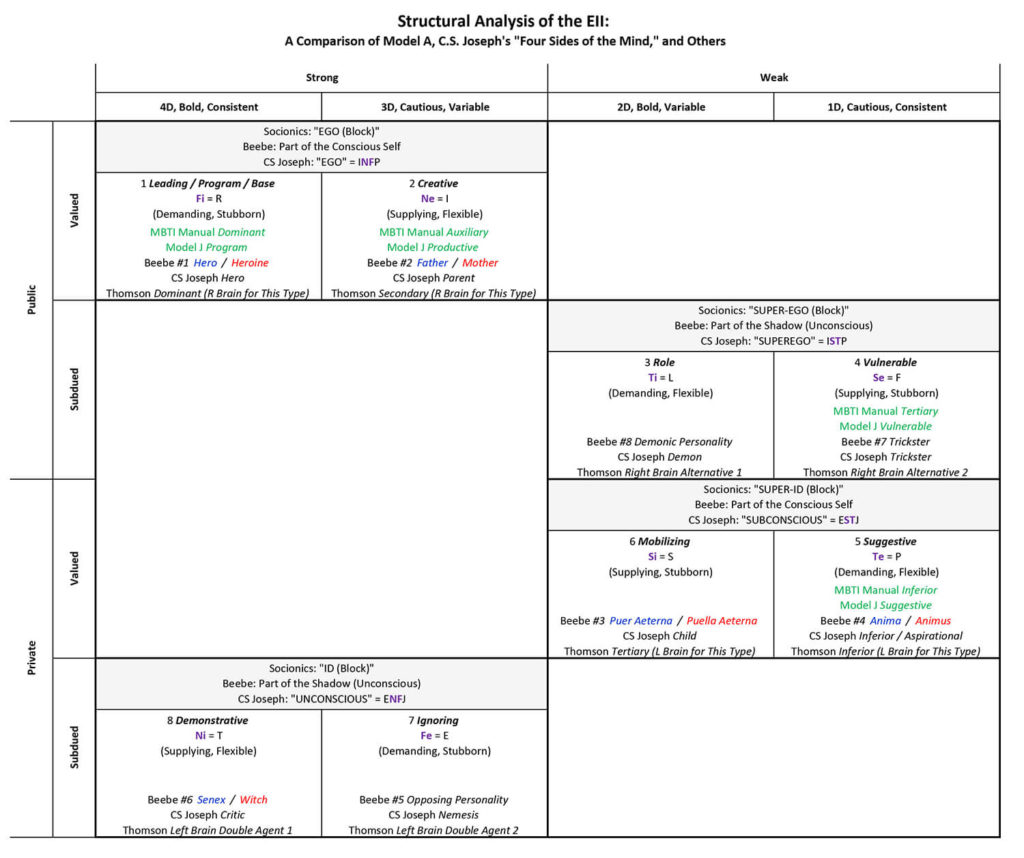Exploring Thomson’s Typology Structure
Structure in typology began to interest me back in January when I was reading the book Personality Type: An Owner’s Manual by Lenore Thomson. Of particular interest to me was the chapter “Personality Types Are Also Brain Types.” In it Ms. Thomson stated that PET scans placed each cognitive function in a specific area of the brain:
- Front of Left Brain: Extraverted Thinking, Extraverted Feeling
- Back of Left Brain: Introverted Sensation, Introverted Intuition
- Front of Right Brain: Extraverted Intuition, Extraverted Sensation
- Back of Right Brain: Introverted Feeling, Introverted Thinking
Also surprising to me was that Ms. Thomson identified the Tertiary and Inferior functions as the weakest of all eight cognitive functions. After the Dominant and Secondary functions, she places two “alternatives” that reside on the same side of the brain. Following those are two “double agents” located on the other side of the brain, where the Tertiary and Inferior functions are located. For me, as an INFJ in the MBTI system, Thomson identified the following as my “type lasagna”:
- Dominant: Introverted Intuition (Left Brain)
- Secondary: Extraverted Feeling (Left Brain)
- Left-Brain Alternatives: Introverted Sensation, Extraverted Thinking
- Right-Brain Double Agents: Introverted Feeling, Extraverted Intuition
- Tertiary: Introverted Thinking (Right Brain)
- Inferior: Extraverted Sensation (Right Brain)
Contrasting C. S. Joseph’s Typology Structure
In contrast to Thomson’s model was one with which I was somewhat more familiar at that time. This was C. S. Joseph’s “four sides of the mind.” Although I am not an expert in his typology, I have viewed a number of his YouTube videos. He assigns a different personality type to each side of the mind. For an INFJ like me, these sides of the mind are:
- Ego: INFJ = Ni Fe Ti Se (see Dominant + Secondary above)
- Unconscious: ENFP = Ne Fi Te Si (see Right-Brain Double Agents above)
- Subconscious: ESTP = Se Ti Fe Ni (see Inferior + Tertiary above)
- Superego: ISTJ = Si Te Fi Ne (see Left-Brain Alternatives above)
Remembering Something about MBTI Typology Structure
While pondering these discrepancies, I was struck by a sudden memory of something I had noticed when skimming through a portion of the MBTI Manual (3rd ed.). In that system, the Secondary, Tertiary, and Inferior functions all have the opposite orientation to the Dominant. Therefore, an INFJ would have:
- Dominant: Introverted Intuition
- Auxiliary (Secondary): Extraverted Feeling
- Tertiary: Extraverted Thinking
- Inferior: Extraverted Sensation
Because this differed from other MBTI-related systems I had encountered, I started to wonder: how are different typologies structured? I should note that my focus was solely on typology structure. As a result, I did not consider the various ways in which cognitive functions or information metabolism elements are defined.
Developing My Structural Analysis
Recently I became quite interested in Socionics. Consequently, I decided to start my analysis with Model A. In that system, my type is EII (Ethical Intuitive Integrator). In addition to the systems I have already mentioned, I also looked at Beebe‘s and Socionics Model J. After working on my diagram for a couple of weeks, I ended up with this:

To download this chart, click here.